THIS CHANGES EVERYTHING.
THE MOST ADVANCED PROCESSOR FOR GAMERS

Configure Your PC
Quick Start Bundles
Core Components
CPU Cooling
Software
Peripherals
Accessories
Welcome to the AMD Custom PC Builder
Ready to build your own PC?
You’ve come to the right place! Use our AMD Custom PC Builder to research and pick PC parts from the thousands of components we have in stock. You can use this to create a gaming PC build with streaming capabilities, or a machine that’s specific to your business.
Next Steps
Once you’ve configured your PC, you can: Save your parts list in the Build Dashboard for later, Share your parts list in our Community Forum, reddit or other forums to get feedback, print it as a shopping list or view a store map to visit one of our stores, add to cart to reserve your choices for in-store pickup.
Enthusiast PC Builders
For the enthusiast PC builders, you can create and save multiple parts lists in your Build Dashboard. Then once you’ve built your custom PC, don’t forget to submit it to the Build Showcase to show it off and help inspire others with your selection and creativity.
AMD PC Builder FAQs
Do I need an aftermarket CPU cooler?
While the stock coolers included with many AMD Ryzen processors are adequate for typical use, an aftermarket cooler is highly recommended for optimal performance, especially if you plan to overclock or push your CPU with demanding tasks. Upgrading to a better cooler can lead to lower temperatures, quieter operation, and higher sustained boost clocks, particularly important for the higher core count CPUs now available.
What chip sockets do AMD processors use?
AMD has transitioned to using primarily Land Grid Array (LGA) sockets for its modern Ryzen and Threadripper processors. This means the pins are located on the motherboard, not the CPU. Key sockets include:
AM4 (PGA): While older, AM4 supported a vast range of Ryzen processors, from the first generation up to the Ryzen 5000 series. While still in use, it is a legacy socket.
AM5 (LGA): The current standard for Ryzen 7000, 8000, and 9000 series processors, AM5 offers support for DDR5 memory and PCIe 5.0, and future compatibility.
sTRX4/TRX40 (LGA): Used for previous generations of AMD Threadripper processors.
sWRX8 (LGA): Used for previous generations of Threadripper PRO processors.
sTR5 (LGA): The current standard for AMD Threadripper and Threadripper PRO processors, offering enhanced features and performance.
It's crucial to ensure your CPU and motherboard have compatible sockets.
What do cores and threads mean for AMD processors?
Cores: The physical processing units within the CPU. More cores generally allow for better multitasking and performance in heavily parallelized workloads.
Threads: Virtual processing units that allow each core to handle multiple tasks simultaneously. This technology, known as Simultaneous Multithreading (SMT), enhances performance in applications that can utilize multiple threads.
AMD offers a wide range of processors with varying core and thread counts, catering to diverse needs from everyday computing to professional workloads, with core counts climbing significantly in the latest Threadripper and Threadripper PRO lines.
What do the letters at the end of the processor mean?
AMD's naming conventions provide insights into processor features:
X / XT / X3D: High performance variants. The X3D designates processors with AMD's 3D VCache technology, providing a large L3 cache for enhanced gaming performance.
No suffix: Standard desktop processor.
G: Integrated Radeon graphics.
GE: Energy efficient processor with integrated Radeon graphics.
How do AMD CPUs overclock?
AMD Ryzen processors are generally unlocked, allowing for manual overclocking. Additionally:
Precision Boost Overdrive (PBO): An automated overclocking feature that optimizes performance based on thermal and power conditions. It can be enabled in the BIOS or through AMD Ryzen Master software.
AMD Ryzen Master: AMD's software utility for monitoring and overclocking Ryzen processors.
What is the difference between Ryzen and Threadripper processors?
Ryzen: Designed for mainstream desktops, offering excellent performance for gaming, content creation, and everyday tasks. They utilize the AM5 platform.
Threadripper / Threadripper PRO: High end desktop (HEDT) and workstation processors designed for demanding professional workloads like 3D rendering, video editing, and scientific simulations. They feature significantly higher core and thread counts, and use the sTR5 platform.
AMD Smart Access Memory (SAM) allows AMD Ryzen 5000 series (and newer) processors to access the full memory of compatible AMD Radeon RX 6000 series (and newer) graphics cards, resulting in improved gaming performance.
How do AMD CPUs attach to the motherboard?For AM5, sTR5, and other LGA sockets, the CPU is carefully placed into the socket, aligning the notches on the CPU with the socket. Then the retention arm is pushed down to secure the CPU. It is important to avoid touching the gold contact pads on the bottom of the CPU. For AM4, the CPU is placed aligning the corner with the triangle, and then a retention arm is lowered to secure the CPU.
Watch the video below for a step by step process of installing AMD CPUs.
Estimated power consumption shown above is a general guide. Actual numbers will vary depending upon additional components chosen and which games or applications are running. Many power supplies run at their peak efficiency at around 50% load, however, our store associates will be happy to help you select the right power supply for your needs.


